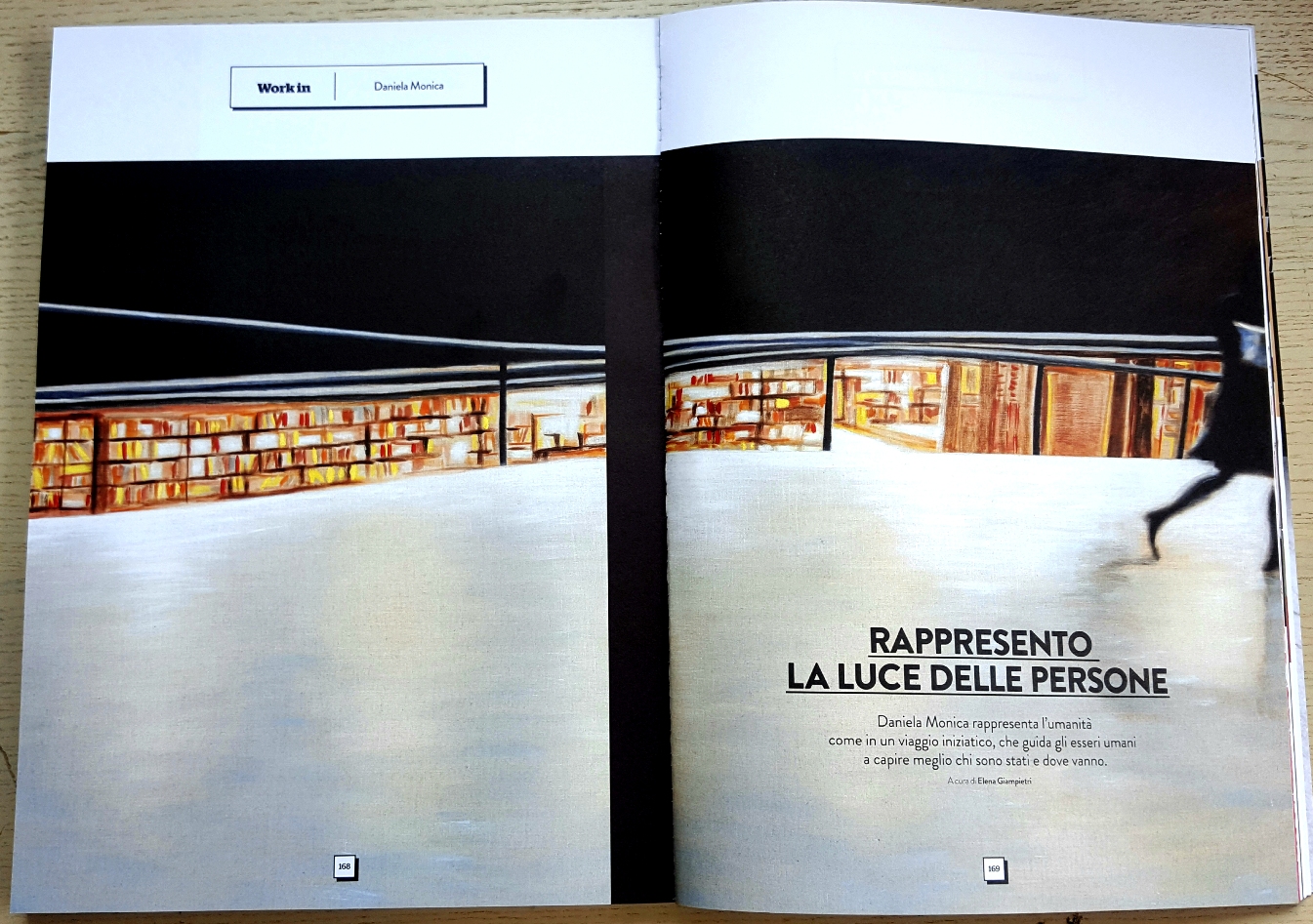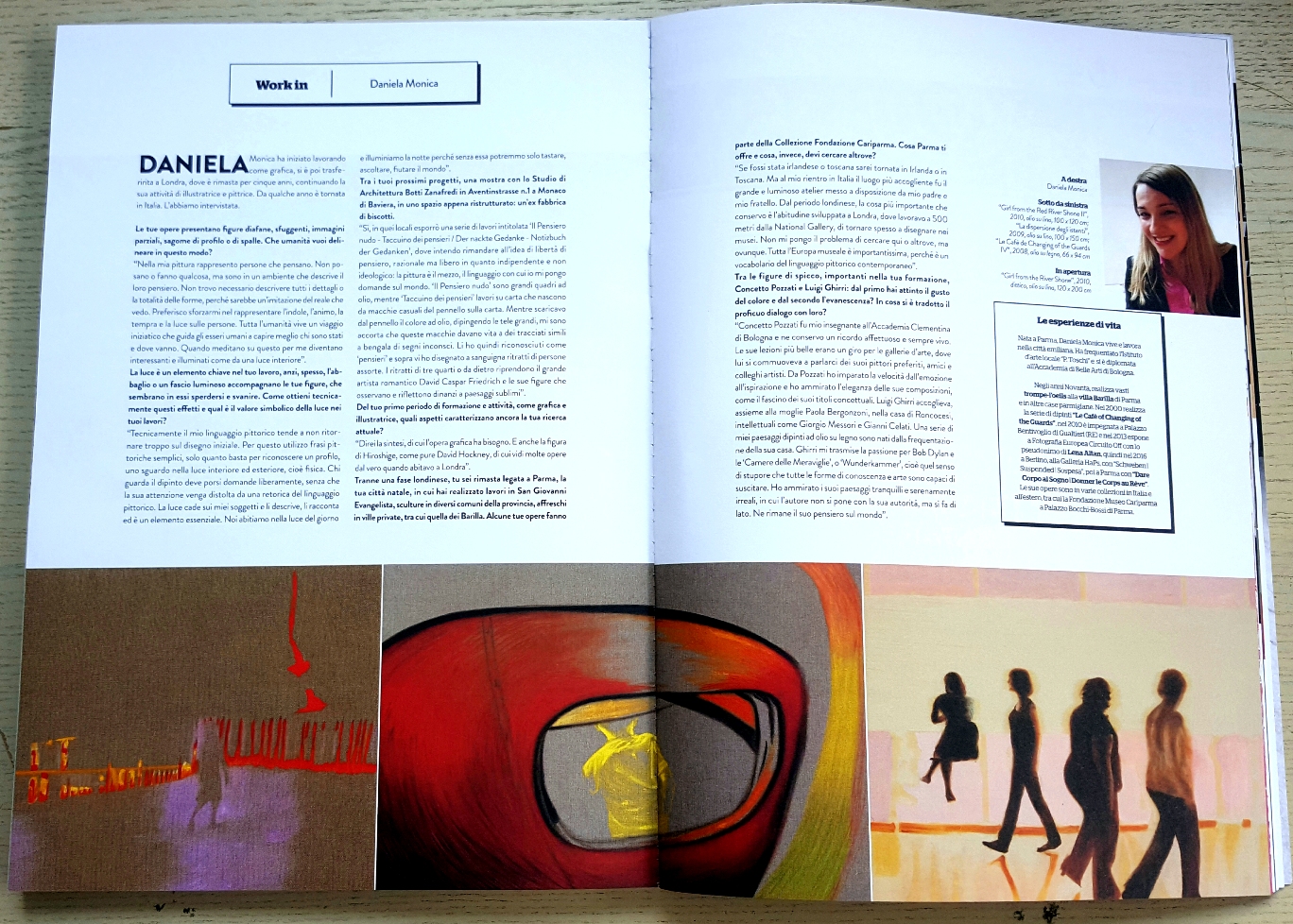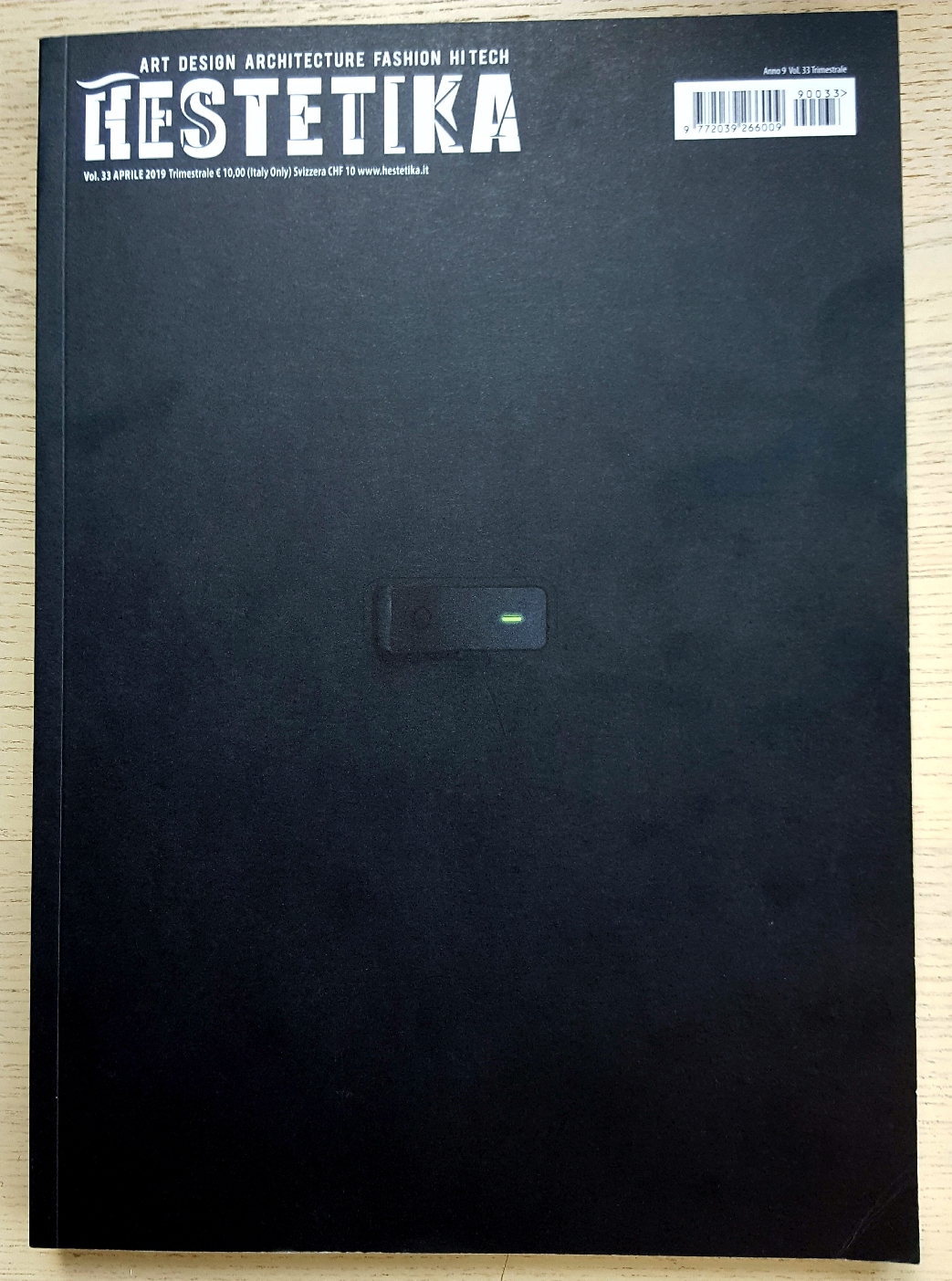
The Heroine’s Journey Questionnaire
* When you want me to place a link to a (youtube) film about you and your work send me the links:
https://www.youtube.com/watch?v=lNCUUf-KxuU
The inner voice | Paintings exhibition by Daniela Monica | 2020
*What is the best thing that I love about my work?
I love the possibility that the pictorial language gives me to express things in life that would be difficult to narrate otherwise, as I also love the priceless value of the emotion or appreciation of those who look at my work.
*What is my idea of happiness?
I think happiness is a good balance between artistic exuberance (that is, the verve that transforms an idea into painting) and artistic hesitation, the unresolved solutions that instead create discomfort and pain, which, however, at the same time gives a precious intellectual lucidity, while exuberance does not. This I think is a happy balance.
*What is my greatest fear?
To no longer reason with the heart, to no longer understand others and to accept external influences.
*What is the trait that I most deplore in myself?
When I am afraid of knowing new things and I organize myself a solitude comfort-zone.
*Which living persons in my profession do I most admire?
Patricia Treib, Matthias Bitzer, Lynette Yiadom Boakye, Robert Pruitt, Firelei Baez, Monika Dillier, Sara Crowner.
*What is my greatest extravagance?
Be silent and act as if I have nothing to say. Stay and see what happens as if I had become just a camera that only records others and life.
*On what occasion would I lie?
I’d be lying to protect someone.
*What is the thing that I dislike the most in my work?
I love my heterogeneous and varied work, but it worries me to see the works of others often more homogeneous than mine, but the comparison, even if tiring, is fertile.
*When and where was I the happiest, in my work?
When I discovered that one of my series of works could contain all my other series.
*If I could, what would I change about myself?
As in Sally Potter’s Orlando from the eponymous novel by Virginia Woolf, I would like to see the world outside the categories of gender and age.
*What is my greatest achievement in work?
When in a gallery, strangers who are not involved in art and have not read any titles or anything else written about my work, they speak to me asking questions fundamental to my life. The questions they felt them there, in my painting, and therefore I think that what I painted works.
*Where would I most like to live?
Short periods, a month, in places where I have never been and in large European cities for at least four seasons, at least a year.
*What is my most treasured possession?
My son and my imagination.
*What is my most marked characteristic?
The swing that is the trend in which I find my vision between opposite situations.
*What is my most inspirational location, in my city?
The roads seen from above, the avenues along the Parma stream and the perspective views in the Park Ducale.
*What is my favourite place to eat and drink, in my city?
Aperitif at the TCafè behind the Baptistery and dinner at the Angiol d’Or next to the Cathedral.
*What books influenced my life and how?
Sculpting in time, Andreij Tarkovskij. All writings, Jorge Luis Borges. Candide ou l’Optimisme, Voltaire, because they are respectively the vision of history, philosophy and the psyche in an artistic key.
*You Only Die Once. What music would I listen on my last day?
Bob Dylan, Madeleine Peyroux and “Lamento às Aguas- Na Beira do mar” by Mateus Aleluia, endlessly.
*Who is my hero or heroine in fiction?
Rosalba, played by Licia Maglietta in Silvio Soldini’s movie Bread and Tulips.
*Who are my heroes and heroines in real life?
My father Ruggero, who was a sort of parmesan Alex Zanardi for energy, willpower and generosity. Cathy Josefowitz: friend, painter and choreographer who fortunately dragged me away from a provincial vision of life and art.
*Which movie would i recommend to see once in a lifetime?
The mirror by Andreij Tarkovskij.
*What role plays art in my life and work?
It has become the way to look at all things and to conceive thoughts. I don’t paint only when I have pencils and brushes in hand, but from when I get up until I lie down again I look at the world with that filter of meanings added by me.
*What do the words ‘You are the storyteller of your own life’ to me?
It may be true. It is a serialized novel. I’m still looking for a publisher.
*Who is my greatest fan, sponsor, partner in crime?
My friend Catherine Rouxel in London. She always receives images of everything I just painted and her raised or lowered thumb has been among the most important for me for decades.
*Which people or companies would I like to work with in 2020? (you can mention a maximum of 10 people and/or companies who could make a real difference in your creative career. I will invite them to tell their story, tell them you mentioned their name and send them your story)
Stampa Gallerie Basel, Galleria Continua San Gimignano.
*Which people in my profession who can make a real difference in my creative career would i love to meet in 2020? (you can mention a maximum of 10 people who could make a real difference in your creative career. I will invite them to tell their story, tell them you mentioned their name and send them your story)
I really don’t know, this year there has been a shift of projects in the near future due to the pandemic. However, I hope to have good proposals and to know good painters and collaborators. Maybe Fiorile by Patti Campani.
*What project, in 2020, am I looking forward to work on?
A new version of the exhibition “The inner voice” curated by Elena Giampietri and staged in 2020 at the Palazzo dei Principi in Correggio, Reggio Emilia, Italy, together with the performance artist Janet Park in new indoor end oudoor locations.
*Where can you see me or my work in 2020?
Cariparma Foundation Museum Palazzo Bossi Bocchi, Parma.
Romalibera Gallery Piazza San Cosimato, Rome.
*What do the words “Passion Never Retires” mean to me?
The passion for one’s job becomes the daily adrenaline. It can never be missing.
*Which creative heroines should Peter invite to tell their story? (you can mention a maximum of 10 people who you would give the opportunity to share their story, i will invite them to tell their story, tell them you mentioned their name and send them your story)
Peter can invite: Krihsanah Silvia, Judith Grassl, Melissa MayerGalbraith, Vania Elettra Tam, Samantha Torrisi, Janet Park, Antonella Mazzoni, Marianna Economu, Laure Cambau, Chiara Montalbani.
*How can you contact me?
Daniela Monica Artist (Facebook)
daniela_monica_artist (Instagram)

RAPPRESENTO LA LUCE DELLE PERSONE
Daniela Monica rappresenta l’umanità
come in un viaggio iniziatico, che guida gli
esseri umani a capire meglio chi sono stati e dove vanno.
Intervista di Elena Giampietri a Daniela Monica
Le tue opere presentano figure diafane, sfuggenti, immagini parziali, sagome di profilo o di spalle. Che umanità vuoi delineare in questo modo?
Nella mia pittura rappresento persone che pensano. Esse non posano o fanno qualcosa, pensano e sono in un ambiente che descrive il loro pensiero. Caspar David Friedrich rappresenta personaggi di spalle che osservano una valle fra le montagne o una luna nascente fra i rami degli alberi. I paesaggi sublimi attorno a loro sono, per me, i loro pensieri. Non trovo necessario nei miei dipinti descrivere tutti i dettagli o la totalità delle forme, perché sarebbe un’imitazione del reale che vedo. Preferisco sforzarmi nel rappresentarne l’indole, l’animo, la tempra e la luce sulle persone. Tutta l’umanità vive un viaggio iniziatico che guida a capire meglio chi sono stati e dove vanno. Quando meditano su questo per me diventano interessanti e illuminati come da una luce interiore.
La luce è un elemento chiave nel tuo lavoro, anzi, spesso, l’abbaglio, un fascio luminoso accompagnano le tue figure che sembrano in esso sperdersi e svanire. Come ottieni tecnicamente questi effetti e quale il valore simbolico della luce nei tuoi lavori?
Tecnicamente il mio linguaggio pittorico tende a non ritornare troppo sul mio disegno iniziale. Frasi pittoriche semplici, solo quanto basta per riconoscere un profilo, uno sguardo nella luce interiore ed esteriore, cioè fisica. Si può dire quasi, che disegni ad olio sul tela e non voglia aggiungere di più. Chi guarda il dipinto deve porsi domande liberamente, senza che la sua attenzione venga distolta da una retorica del linguaggio pittorico. La luce cade sui miei soggetti e li descrive. E’ la luce a raccontarli ed è un elemento essenziale nella mia pittura. Noi abitiamo nella luce del giorno e illuminiamo la notte perché senza la luce potremmo solo tastare, ascoltare, fiutare e gustare il mondo. Abbiamo bisogno di essere illuminati dalla solarità del pensiero per aberrare idee scellerate che la delusione ci fa prendere con la pancia. A volte quando rappresento una persona indefinita ed abbagliata da un fascio di luce, in parte è anche perché lei stessa non sa definirsi, non si conosce abbastanza. Vediamo solo ciò che conosciamo, ma crescendo il nostro pensiero interiore aggiunge dettagli alla visione della realtà.
Tra i tuoi prossimi progetti, una mostra con lo Studio di Architettura Botti Zanafredi in Aventinstrasse 1 a Monaco di Baviera, in uno spazio appena ristrutturato: un’ex fabbrica di biscotti.
Si, in quei locali esporrò una serie di lavori intitolata Il Pensiero nudo – Taccuino dei pensieri / Der nackte Gedanke – Notizbuch der Gedanken, dove intendo rimandare all’idea di libertà di pensiero, razionale ma libero in quanto indipendente e non ideologico: la pittura è il mezzo, il linguaggio con cui io mi pongo domande sul mondo.
Il Pensiero nudo sono grandi quadri ad olio, mentre Taccuino dei pensieri sono lavori su carta e nascono da macchie casuali del pennello sulla carta.
Mentre scaricavo dal pennello il colore ad olio, dipingendo le tele grandi, mi sono accorta che queste macchie davano vita a dei tracciati simili a bengala di segni inconsci. li ho quindi riconosciuti come pensieri e sopra vi ho disegnato a sanguigna ritratti di persone assorte. I ritratti di tre quarti o da dietro riprendono il grande artista romantico Casper David Friedrich e sue figure che osservano e riflettono dinanzi a paesaggi sublimi.
Del tuo primo periodo di formazione e attività, come grafica ed illustratrice, quali aspetti caratterizzano ancora la tua ricerca attuale?
Direi la sintesi, di cui l’opera grafica ha bisogno. Anche la figura di Hiroshige, come pure David Hockney, di cui vidi molte opere dal vero quando abitavo a Londra.
Tranne una fase londinese, tu sei rimasta legata a Parma, la tua città natale, in cui hai realizzato lavori in San Giovanni Evangelista, sculture in diversi Comuni della Provincia, affreschi in ville private, tra cui quella dei Barilla. Alcune tue opere fanno parte della Collezione Fondazione Cariparma. Cosa Parma ti offre e cosa, invece, devi cercare altrove?
Se fossi stata irlandese o toscana sarei tornata in Irlanda o in Toscana. Ma al mio rientro in Italia il luogo più accogliente fu il grande e luminoso atelier messo a disposizione da mio padre e mio fratello. Dal periodo londinese, la cosa più importante che conservo è l’abitudine sviluppata a Londra, dove lavoravo a 500 metri dal National Gallery, di tornare spesso a disegnare nei musei.
Non mi pongo il problema di cercare qui o altrove, ma ovunque. Tutta l’Europa museale è importantissima, perché è un vocabolario del linguaggio pittorico contemporaneo.
Tra le figure di spicco importanti nella tua formazione, Concetto Pozzati e Luigi Ghirri: dal primo hai attinto il gusto del colore e dal secondo l’evanescenza? In cosa si è tradotto il proficuo dialogo con loro?
Concetto Pozzati fu mio insegnante all’Accademia Clementina di Bologna e ne conservo un ricordo affettuoso e sempre vivo. Le sue lezioni più belle erano un giro per Gallerie d’Arte dove lui si commuoveva a parlarci dei suoi pittori preferiti, amici e colleghi artisti. Da Pozzati ho imparato la velocità dall’emozione all’ispirazione e ho ammirato l’eleganza delle sue composizioni, come il fascino dei suoi titoli concettuali.
Luigi Ghirri accoglieva, assieme alla moglie Paola Bergonzoni, nella loro casa di Roncocesi, intellettuali come Giorgio Messori e Gianni Celati. Una serie di miei paesaggi dipinti ad olio su legno sono nati dalla frequentazione della sua casa. Ghirri mi trasmise la passione per Bob Dylan e le Camere delle Meraviglie, o “Wunderkammer”, cioè quel senso di stupore che tutte le forme di conoscenza e arte sono capaci di suscitare. .
Ho ammirato i suoi paesaggi tranquilli e serenamente irreali, in cui l’autore non si pone con la sua autorità, ma si fa di lato. Ne rimane il suo pensiero sul mondo.



